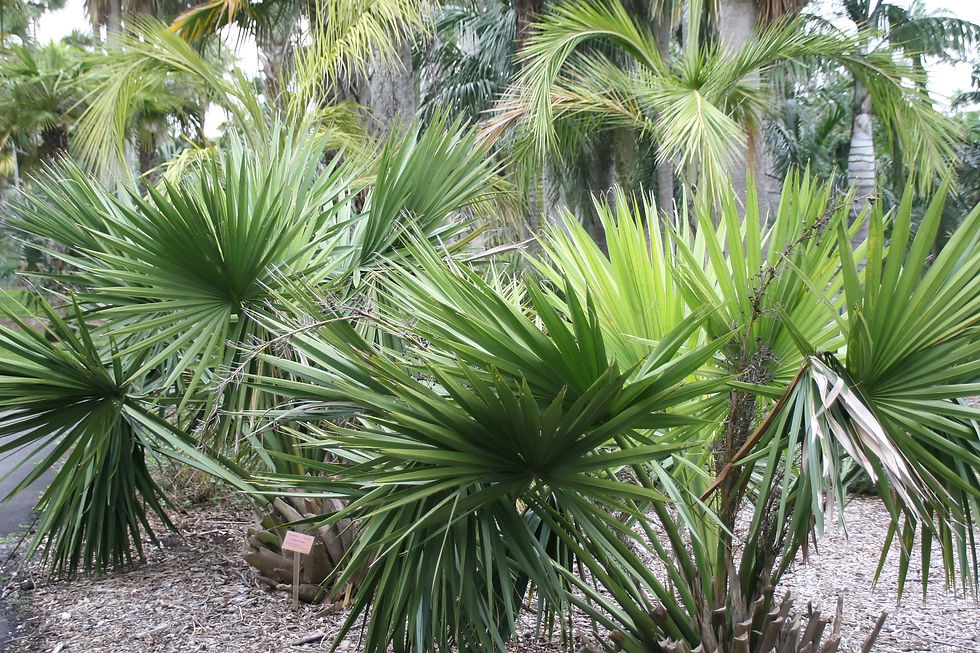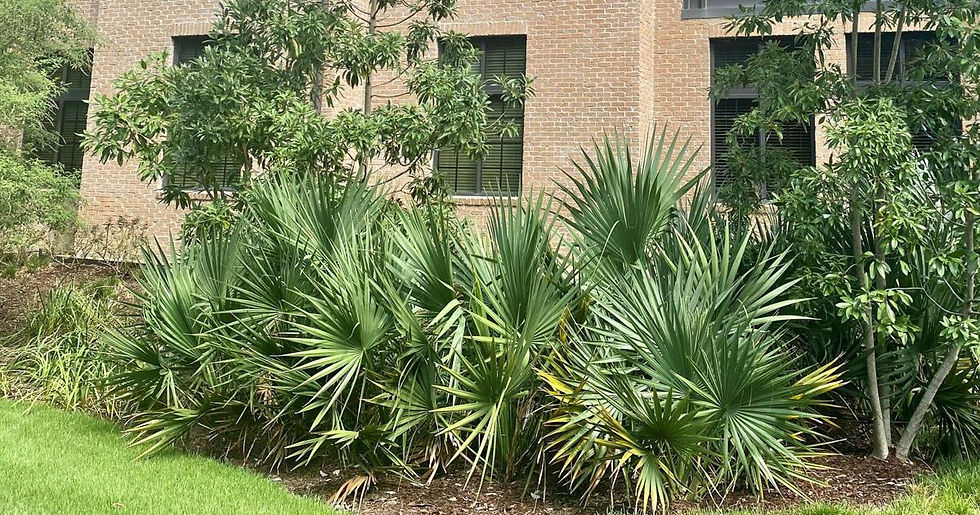A Closer Look at Austin’s Favorite Palm, Dwarf Palmettos
- Dake Land Design

- Feb 14, 2024
- 4 min read
Updated: May 23, 2024
What is a Dwarf Palmetto?
What is a dwarf palmetto, you ask? This fan-shaped, shrub-like palm is one of Dake Land Design’s favorite plants to design with here in Austin and, more than likely, you have seen the dwarf palmetto around town. This plant is as fascinating as it is resilient and it adds a unique aesthetic touch to a variety of landscapes. These plants belong to the palm family and are native to Austin and the southeastern United States. Dwarf palmettos play a significant role in the ecosystem and have interesting visual characteristics that make them stand out. In this blog post, we will explore the world of dwarf palmetto as we discover their anatomy, habitat, ecological importance, and ways to incorporate them into your own landscape. By the end of the blog you will surely see why the palm is high on landscape designer Christian Dake’s list of plants to incorporate into his projects.

What does a dwarf palmetto look like and where is it found?
Dwarf palmettos are recognized for their distinctive fan-shaped fronds. A frond is a leaf or leaf-like part of a palm tree. These fronds, which grow up to ten feet in length, are deeply divided, which creates a striking visual effect. The leaves are typically a vibrant green color, which gives the plant a lush and tropical appearance. Despite their modest size, dwarf palmettos can produce a significant number of fronds, which form dense clusters that contribute to their unique aesthetic appeal.
Unlike larger palm species, the trunk of dwarf palmettos resides and grows underground, which makes this plant a rhizome. This horizontal subterranean stem allows the plant to spread and form clumps. The trunk remains short, usually not exceeding a few feet in height, contributing to the plant's modest appearance. This growth habit is an adaptation that helps the plant withstand challenging environmental conditions, which makes it a viable option for your Austin landscape.
Dwarf palmettos are primarily found in the southeastern United States, such as in the great state of Texas, and thrive in a variety of habitats. They are commonly spotted in pine flatwoods, coastal plains, and sandy soils. These resilient plants have also adapted to thrive in both wet and dry conditions, which makes them versatile survivors in different ecosystems. If you have been on the Ann Richards Hike and Bike Trail - or Townlake - whichever term you use for nearly everyone’s favorite trail by the lake, most likely you have seen some of these lovely palms.
Along the coastal plains, dwarf palmettos endure salt spray and sandy soils. Their ability to tolerate these harsh conditions makes them a valuable component of coastal landscapes, providing stability and preventing soil erosion. Parts of Austin have sandy soil which makes it a desirable plant to retain the soil in your yard.
In pine flatwoods, dwarf palmettos coexist with pine trees and other vegetation. The combination of their fan-shaped fronds and the vertical trunks of pines creates a visually appealing and diverse ecosystem.
What does the dwarf palmetto do for the ecosystem?
In addition to their pleasing look which brings to mind tropical environments, dwarf palmettos serve as crucial habitats for various wildlife species. The dense clusters of fronds provide shelter and nesting sites for birds, while the plant's berries attract small mammals and insects. In addition, the structure of dwarf palmettos offers protection to amphibians and reptiles, contributing to the overall biodiversity of their habitats.
In terms of landscaping importance, the extensive root system of dwarf palmettos plays a vital role in stabilizing soil. In areas prone to erosion, these plants help prevent the loss of topsoil and so thus maintain the health of the ecosystem. Their ability to thrive in sandy soils makes them particularly effective in regions where soil retention is a challenge. This is yet another reason this plant is a top choice for Christian Dake when designing for soil-challenged Austin landscapes.
How do I incorporate dwarf palmettos into my landscape?
If you're looking to enhance your landscape with a touch of the tropical, dwarf palmettos can be an excellent choice. Dake Land Design has three tips on how to incorporate these modest-sized palms into your landscaping.
First off, plant in groups. Create clusters of dwarf palmettos to mimic their natural growth habit. This design strategy can add a dynamic pattern to your landscape.
Secondly, find companion plants for your dwarf palmettos. They pair perfectly with other native plants that thrive in similar conditions. This not only enhances the visual appeal with dynamism but also creates a more sustainable and resilient landscape.
Lastly, consider the use of containers. Due to their compact size, dwarf palmettos can thrive in containers. This allows you to enjoy their beauty on patios, balconies, or even indoors if provided with adequate light.

Final palmetto rave
What we love most about the dwarf palmetto is that it thrives in both sun and shade and can be styled in so many ways. These characteristics make it a resilient, versatile and aesthetically pleasing native plant. Dwarf palmettos, with their unique anatomy and ecological importance, bring a touch of the wild to landscapes in Austin. Whether you encounter these tropical palms in their natural environment or choose to incorporate them into your yard, dwarf palmettos are sure to capture your attention with their presence. Explore the world of these small wonders and discover the beauty they can add to the rich tapestry of your landscape.
Are you ready to realize your dreams of landscape transformation? Fill out our contact form and begin your conversation with Dake Land Design. Also leave a comment we love to hear from you!
.png)




Comments